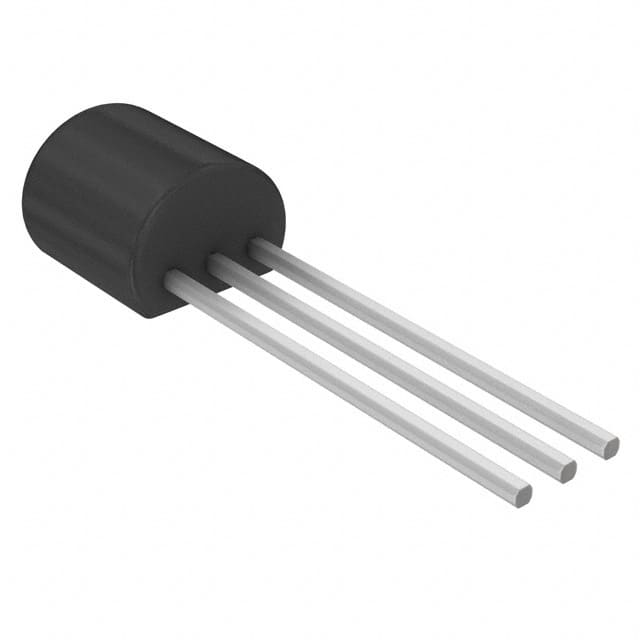Zie specificaties voor productdetails.

2N5770 Transistor
Product Overview
The 2N5770 is a general-purpose PNP bipolar junction transistor (BJT) commonly used in electronic circuits for amplification and switching applications. This transistor belongs to the category of discrete semiconductor devices and is widely utilized in various electronic systems due to its versatile characteristics.
Basic Information Overview
- Category: Discrete Semiconductor Device
- Use: Amplification and Switching
- Characteristics: High current gain, low noise, and low power dissipation
- Package: TO-92 package
- Essence: PNP BJT
- Packaging/Quantity: Typically available in reels or tubes containing multiple units
Specifications
- Collector-Base Voltage (Vcbo): -50V
- Collector-Emitter Voltage (Vceo): -45V
- Emitter-Base Voltage (Vebo): -5V
- Collector Current (Ic): -100mA
- Power Dissipation (Pd): 625mW
- Transition Frequency (ft): 150MHz
- Operating Temperature Range: -65°C to +200°C
Detailed Pin Configuration
The 2N5770 transistor features three pins: Collector (C), Base (B), and Emitter (E). The pin configuration is as follows: - Collector (C): Pin 1 - Base (B): Pin 2 - Emitter (E): Pin 3
Functional Features
The 2N5770 transistor offers the following functional features: - High current gain for amplification purposes - Low noise characteristics suitable for signal processing applications - Low power dissipation, making it energy-efficient
Advantages and Disadvantages
Advantages
- High current gain allows for efficient signal amplification
- Low noise characteristics make it suitable for sensitive electronic applications
- Compact TO-92 package enables easy integration into circuit designs
Disadvantages
- Limited maximum collector current compared to other transistors
- Relatively lower transition frequency may restrict high-frequency applications
Working Principles
The 2N5770 operates based on the principles of bipolar junction transistors. When a small current flows into the base terminal, it controls a larger current between the collector and emitter terminals, allowing the transistor to amplify or switch electronic signals.
Detailed Application Field Plans
The 2N5770 transistor finds extensive use in various electronic applications, including but not limited to: - Audio Amplifiers - Signal Processing Circuits - Switching Circuits - Oscillator Circuits - Voltage Regulators
Detailed and Complete Alternative Models
Several alternative models to the 2N5770 include: - 2N3904 - BC557 - 2N4403 - BC558 - 2N3906
In conclusion, the 2N5770 transistor serves as a versatile component in electronic circuits, offering reliable amplification and switching capabilities while being suitable for a wide range of applications.
[Word Count: 443]
Noem 10 veelgestelde vragen en antwoorden met betrekking tot de toepassing van 2N5770 in technische oplossingen
What is the 2N5770 transistor used for?
- The 2N5770 is a general-purpose NPN bipolar junction transistor commonly used for amplification and switching applications.
What are the typical operating conditions for the 2N5770?
- The 2N5770 typically operates at a maximum collector current of 100mA, with a maximum collector-emitter voltage of 50V.
How can the 2N5770 be used in amplifier circuits?
- The 2N5770 can be used as a small-signal amplifier in audio and radio frequency (RF) circuits due to its low noise and high gain characteristics.
Can the 2N5770 be used for switching applications?
- Yes, the 2N5770 can be used for low-power switching applications such as signal routing and digital logic circuits.
What are the key features of the 2N5770 transistor?
- The 2N5770 features low noise, high current gain, and low power dissipation, making it suitable for various low-power applications.
Are there any specific considerations for designing circuits with the 2N5770?
- When designing circuits with the 2N5770, it's important to consider its maximum ratings, biasing requirements, and thermal considerations to ensure reliable operation.
What are some common alternatives to the 2N5770?
- Common alternatives to the 2N5770 include transistors such as 2N3904, BC547, and 2N2222, which offer similar characteristics and can be used in similar applications.
Can the 2N5770 be used in high-frequency applications?
- While the 2N5770 can be used in RF circuits, it may not be suitable for very high-frequency applications due to its transition frequency and capacitance characteristics.
What are the typical package options for the 2N5770?
- The 2N5770 is commonly available in TO-92 packages, which are suitable for through-hole PCB mounting and prototyping.
Where can I find detailed datasheets and application notes for the 2N5770?
- Detailed datasheets and application notes for the 2N5770 can be found on semiconductor manufacturer websites, distributor platforms, and electronics component databases.

